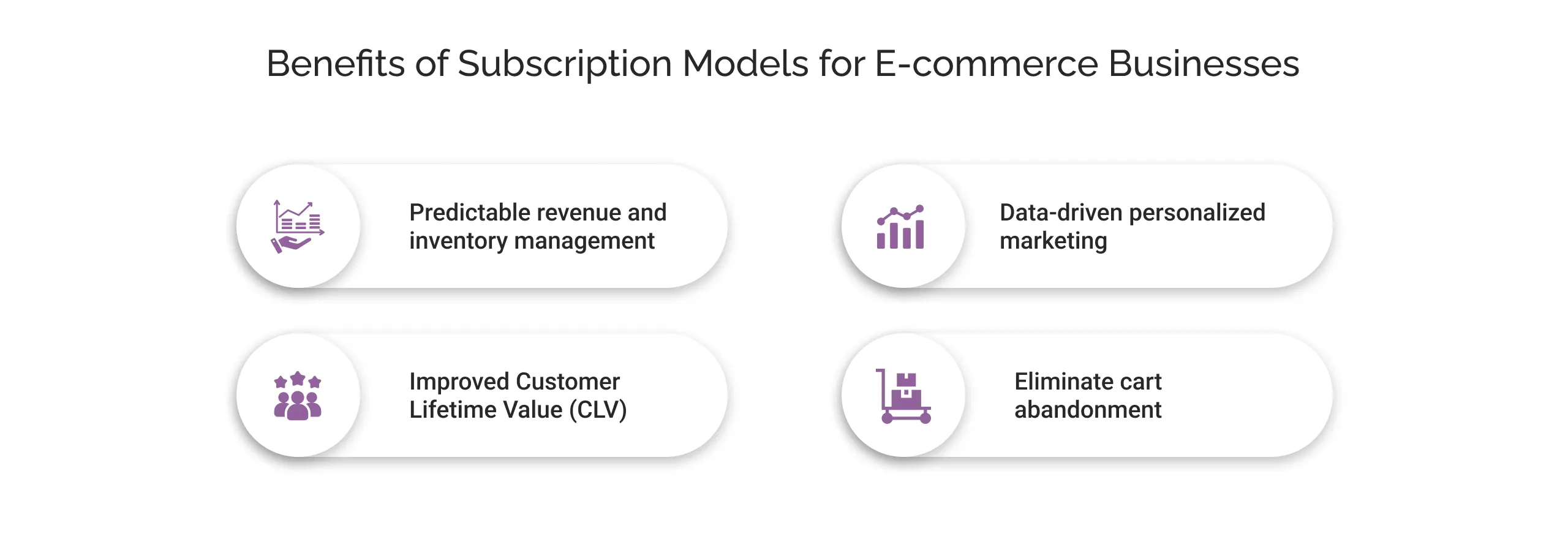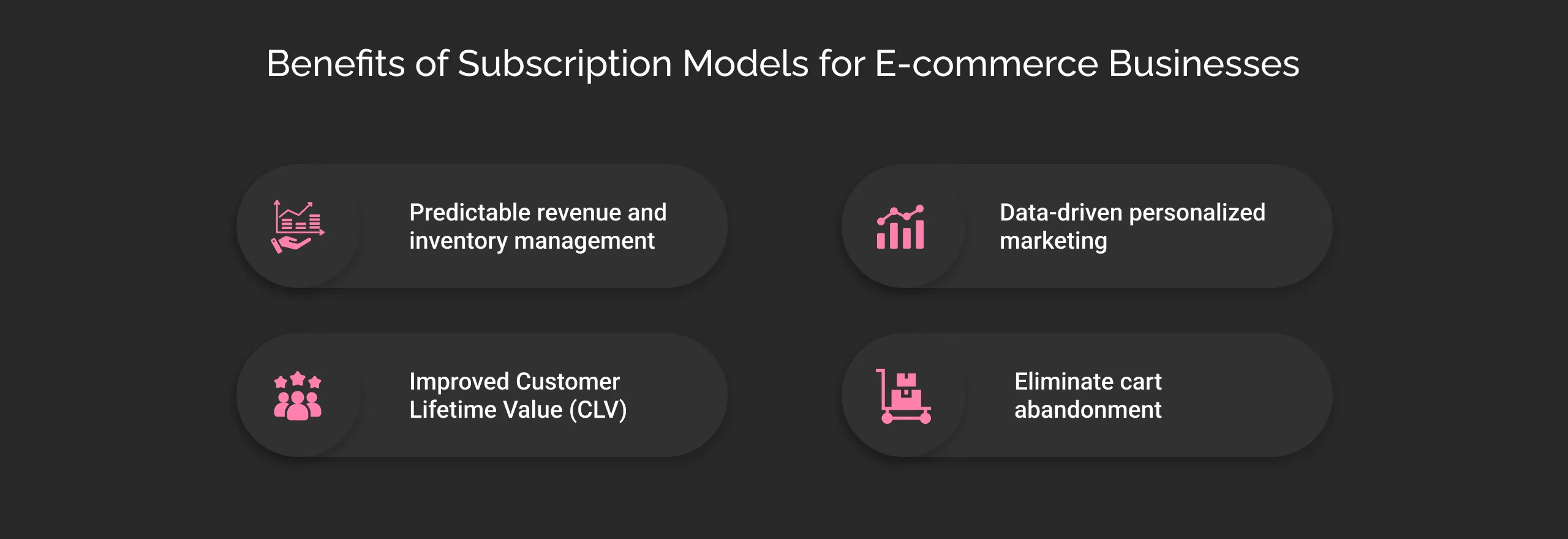How is the E-Commerce Business Subscription Model Beneficial?
Table of Contents
Acquiring a new customer now costs $29 to e-commerce businesses while retaining one through subscriptions boosts spending by 67%.
It explains why forward-thinking businesses are not just selling products/services, they are focusing on building recurring revenue engines through e-commerce subscription models.
From Amazon’s Subscriber & Save program for everyday essentials to BarkBox’s curated pet products, the subscription model is transforming the e-commerce industry by combining convenience with recurring value. But how do they work, and why should your business adopt one?
Let’s break it down.
What is an E-commerce Subscription Model?
A subscription model is a strategy where customers pay a recurring fee, typically monthly, quarterly, or annually, to receive products or services regularly.
It shifts the focus from transactional sales to ongoing customer engagement, helping businesses create a steady revenue stream.
For example, Birchbox offered a curated sample box for an affordable monthly subscription and provided a low-risk way for consumers to explore new products based on their customer preferences and purchase history.
How Does an E-commerce Subscription Model Work?


A subscription model in e-commerce replaces the traditional one-time transaction with automated recurring deliveries or services. Here’s its lifecycle:
1. Customer acquisition: Firstly, businesses have to design a subscription offer that provides immediate value that can convert casual consumers into subscribers. This means creating membership plans that solve specific customer pain points, like a $10/month trial for an e-commerce app offering AI-powered editing, which lets merchants test essential features before committing.
2. Recurring billing: Businesses can set fixed payments that are automatically charged at fixed intervals (handled by payment gateways) with transparency (clear renewal dates and cancellation policies).
3. Retention and personalization: With the collected subscriber data (purchase history, customer preferences), companies can suggest tailored recommendations (e.g., you loved the X facewash, now try our newly launched facewash pack (free) with the purchase of the same).
4. Scalability and optimization: As the subscriber base grows, companies can leverage analytics to predict churn (customers canceling subscriptions or failing to renew) and test pricing tiers (basic/premium) to maximize customer lifetime value.
This seamless automation is where platforms like Salesforce Commerce Cloud excel by integrating CRM, billing, and inventory management for a seamless subscriber experience.
What are the Types of Subscription Models in E-commerce?


There are various types of subscription models in e-commerce. Having an understanding of each model enables you to choose the right model for your e-commerce business.
Auto-ship subscription
The auto-ship/replenishment subscription model is designed for businesses selling products that customers use regularly and need to repurchase. It allows customers to have their essentials delivered to them at specific intervals, while organizations have a steady revenue stream.
Simply put, customers subscribe to receive essential goods such as vitamins, pet foods, and razors at fixed intervals (monthly or quarterly).
For example, Amazon’s “Subscribe & Save” demonstrates auto-ship’s capability that lets customers schedule automatic deliveries of household essentials like coffee pods or detergent. Subscribers get discounts, while Amazon secures repeat purchases without marketing spend.
Curation subscription
Curation subscription is designed to deliver a personalized, often surprise-based experience. It is popular in industries where discovery is a part of the appeal, such as fashion, beauty, gourmet foods, etc.
In simple terms, subscribers pay a recurring fee to receive a curated selection of products tailored to their preferences. Unlike auto-ship, its value lies in the surprise element and expertly personalized selection.
For example, Atlas Coffee Club exemplifies curation’s power–subscribers receive premium single-origin coffee from a new country each month, with cultural storytelling and brewing guides. They transform a routine coffee purchase into a discovery experience for consumers.
Access subscription
The access subscription model grants subscribers exclusive/ VIP benefits such as early product release, member-only discounts, etc. This is best suited for brands with a strong community or luxury appeal.
Simply put, customers pay a recurring fee, in an access subscription model, to unlock exclusive perks that are not available to one-time buyers.
For example, Amazon Prime is the best example of an access subscription model, offering free delivery, streaming, and exclusive deals to the subscriber.
Benefits of Subscription Models for E-commerce Businesses


For e-commerce businesses battling rising acquisition costs and unpredictable sales, the subscription model is not just an option; they are essential. Here’s how they solve critical pain points for e-commerce:
Predictable revenue and inventory management
Subscription models in e-commerce transform one-time (unpredictable) sales into reliable recurring income. It provides you with a clear understanding of subscriber numbers to forecast sales, manage inventory efficiently, and gain deep insights into customers’ preferences.
For example, Dollar Shave Club leveraged subscriptions by offering a monthly subscription that helped them acquire 3.2 million subscriber in the four years of launching, and their revenue is estimated at $40.1 million in 2025. They secure constant demand for razors, enabling bulk purchasing discounts and optimizing warehouse operations.
Improved Customer Lifetime Value (CLV)
A subscriber spends 67 percent more than a new (one-time) customer.
Take Honest Company as an example; they built a $378,340 revenue stream by offering subscription bundles for diapers and baby products. Parents valued the convenience, while the company increased the average subscriber lifespan, which helped drive increased revenue.
Data-driven personalized marketing
The subscription model provides actionable customer behavioral data such as product preferences, purchase frequency, and engagement patterns. This empowers e-commerce businesses to provide hyper-personalized experiences that generic e-commerce stores can’t provide.
For example, Stitch Fix collects subscriber data such as feedback through customer swiping in different styles in the entire collection. This data enables them to understand styling algorithms, providing clothing based on the customer’s needs, leading to increased average order value.
Eliminate cart abandonment
70.19 % of shoppers leave before completing their purchase, according to the Baymard Institute’s cart abandonment stats. Subscriptions remove this hurdle by automating repeat purchases and reducing decision fatigue (e.g., the order will arrive in 7-10 days). While subscriptions offer immense potential, executing them requires the right technology, which is where Salesforce Commerce Cloud comes in.

How Does Salesforce Commerce Cloud Enhance Subscription Models?
Salesforce Commerce Cloud is a powerful platform for subscription-based businesses as it offers features:
- AI-powered personalization: Salesforce’s Einstein AI analyzes subscriber behavior to recommend products.
- Unified customer view: It integrates seamlessly with Salesforce products like Sales Cloud, helping e-commerce businesses to track customer behavior to predict and reduce churn.
- Scalable: Designed to scale as your e-commerce business grows (e.g., subscriber base grows), handling high transaction volumes without performance degradation.
For businesses looking to implement or optimize their subscription model, Cyntexa’s Salesforce Commerce Cloud experts can streamline the transition and help design automated workflows, ensuring the right workflows, automation, and integrations are in place.
Don’t Worry, We Got You Covered!
Get The Expert curated eGuide straight to your inbox and get going with the Salesforce Excellence.
AUTHOR
Priyanshu
Salesforce Commerce Cloud Expert
Priyanshu, a Commerce Cloud expert, has 6+ years of experience and 8+ certifications. He specializes in crafting seamless, scalable e-commerce solutions that enhance customer experiences, maximize conversions in the digital marketplace. His expertise ensures businesses stay agile, competitive, and customer-centric.


Cyntexa.
Join Our Newsletter. Get Your Daily Dose Of Search Know-How







